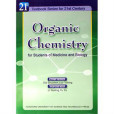《Organic Chemistry(Second Edition)》是華中科技大學出版社出版的圖書,作者是Chief Compilers、XiaShuzhen、Luo Yiming、FengWenfang。
基本介紹
- 中文名:Organic Chemistry(Second Edition)
- 作者:Chief CompilersXiaShuzhen Luo Yiming FengWenfang
- 出版社:華中科技大學出版社
- 頁數:445 頁
- ISBN:9787560936475
- 定價:51.8 元
- 開本:16 開
內容簡介,作者簡介,目錄,
內容簡介
This book is written for a one-semester course in organic chemistry, which is especially suitable for students majoring in biology and medical sciences. It consists of 17 chapters organized by functional group of organic compounds. With plenty of in-chapter and additional problems and moreover the answers attached, this book delivered an effective, clear and understandable approach to learn.
作者簡介
目錄
Contents
Chapter 1 Introduction (1)
1.1 Organic Compounds and Organic Chemistry (1)
1.2 Bonding in Organic Compounds (2)
1.3 Attractions between Molecules (10)
1.4 Classification and Reaction Types of Organic Compounds (12)
1.5 Acid-Base Theory (14)
Additional Problems (17)
Chapter 2 Alkanes and Cycloalkanes (19)
2.1 Alkanes (19)
2.2 Cycloalkanes (35)
Essay:Radical in Biology, Medicine and Industry (47)
Additional Problems (48)
Chapter 3 Alkenes and Alkynes (50)
3.1 Structure of Alkenes and Alkynes (50)
3.2 Nomenclature of Alkenes and Alkynes (52)
3.3 Cis-Trans Isomerism in Alkenes (54)
3.4 Electronic Effect (57)
3.5 Resonance Structure (60)
3.6 Physical Properties of Alkenes and Alkynes (62)
3.7 Chemical Properties of Alkenes and Alkynes (64)
3.8 Conjugated Dienes (76)
Essay:Terpenes—Naturally Occurring Alkenes (78)
Additional Problems (79)
Chapter 4 Aromatic Compounds (82)
4.1 Benzene:Structure and Bonding (82)
4.2 Nomenclature of Aromatic Compounds (84)
4.3 Physical Properties of Aromatic Compounds (85)
4.4 Chemical Properties of Aromatic Compounds (86)
4.5 Fused-Ring Aromatic Hydrocarbons (94)
4.6 Aromaticity — Hückel Rule (96)
Essay:Cancer and Carcinogens (97)
Additional Problems (99)
Chapter 5 Enantiomerism (102)
5.1 Enantiomers (103)
5.2 Measurement of Optical Activity (105)
5.3 Representation of Enantiomer—Fischer Projection Formula (107)
5.4 Nomenclature of Enantiomer (108)
5.5 Stereoisomers with Two Chiral Carbon Atoms (110)
5.6 Enantiomers without Chiral Carbon Atoms (112)
5.7 Enantiomers in Cyclic Compounds (113)
5.8 Properties of Enantiomer (114)
5.9 Resolution of Enantiomers (115)
5.10 Reform of Chiral Molecules and Biological Function (116)
Essay:Stereoisomerism in the Biological World (118)
Additional Problems (119)
Chapter 6 Halohydrocarbons (122)
6.1 Classification and Nomenclature of Halohydrocarbons (122)
6.2 Physical Properties of Halohydrocarbons (124)
6.3 Chemical Properties of Halohydrocarbons (125)
Essay:Naturally Occurring Organohalogen Compounds (137)
Additional Problems (138)
Chapter 7 Alcohols, Phenols, and Ethers (142)
7.1 Alcohols (142)
7.2 Phenols (153)
7.3 Ethers (161)
7.4 Epoxides (164)
7.5 Sulfur Analogues of Alcohols and Ethers:Thiols and Sulfides (168)
Essay:Measuring Blood Alcohol (171)
Addition Problems (172)
Chapter 8 Aldehydes and Ketones (175)
8.1 Classification and Nomenclature of Aldehydes and Ketones (175)
8.2 Structure of Aldehydes and Ketones (177)
8.3 Physical Properties of Aldehydes and Ketones (178)
8.4 Chemical Properties of Aldehydes and Ketones (178)
Essay:Some Biological Nucleophilic Addition Reaction (189)
Addition Problems (190)
Chapter 9 Carboxylic Acids and Substituted Acids (193)
9.1 Carboxylic Acids (193)
9.2 Hydroxy Acids (202)
9.3 Keto-Acids (206)
Essay:Food Preservatives (207)
Additional Problems (208)
Chapter 10 Derivatives of Carboxylic Acids (211)
10.1 Classification and Structure of Carboxylic Acid Derivatives (211)
10.2 Nomenclature of Carboxylic Acid Derivatives (211)
10.3 Physical Properties of Carboxylic Acid Derivatives (214)
10.4 Chemical Properties of Carboxylic Acid Derivatives (214)
10.5 Urea and Barbiturates (221)
Essay:N-nitrosamines in Drinking Water (223)
Additional Problems (224)
Chapter 11 Amines (227)
11.1 Classification and Nomenclature of Amines (227)
11.2 Structure of Amines (230)
11.3 Physical Properties of Amines (232)
11.4 Chemical Properties of Amines (233)
11.5 Aromatic Diazonium Salts (239)
11.6 Alkaloids (244)
Essay:Local Anesthetics and cocaine (245)
Additional problems (246)
Chapter 12 Spectroscopy of Organic Compounds (250)
12.1 General Principle of Absorption Spectra (250)
12.2 Ultraviolet-Visible Spectra (252)
12.3 Infrared Spectra (256)
12.4 Nuclear Magnetic Resonance Spectra (265)
12.5 Mass Spectrometry (277)
Essay:Magnetic Resonance Imaging (279)
Additional Problems (281)
Chapter 13 Heterocycles (283)
13.1 Classification and Nomenclature of Heterocycles (283)
13.2 Structure and Properties of Five-Membered Aromatic Heterocycles (284)
13.3 Structure and Properties of Pyridine and Pyrimidine (288)
13.4 Fused-Heterocyclic Compounds (291)
13.5 The Sulfa Drugs (292)
Additional Problems (293)
Chapter 14 Carbohydrates (296)
14.1 Classification and Nomenclature of Carbohydrates (297)
14.2 Monosaccharides (297)
14.3 Disaccharides and Polysaccharides (307)
Essay:Diabetes and Low-Calorie Sweeteners (311)
Additional Problems (313)
Chapter 15 Lipids (315)
15.1 Fats and Oils—Triacylglycerols (315)
15.2 Waxes (320)
15.3 Phospholipids (321)
15.4 Steroids (325)
15.5 Steroid Hormones (329)
Essay:Errors in the Metabolism of Fatty Acids-Lorenzo’s Oil (331)
Additional Problems (332)
Chapter 16 Amino Acids, Peptides and Proteins (334)
16.1 Amino Acids (334)
16.2 Peptides (344)
16.3 Proteins (349)
Essay:Sickle Cell Anemia—A Biochemical Disease and Mad Cow Disease (358)
Additional Problems (360)
Chapter 17 Nucleic Acids (362)
17.1 Chemical Structure and Classification of Nucleic Acids (362)
17.2 Nucleosides and Nucleotides (364)
17.3 The Hierarchy of Nucleic Acid Structure (367)
17.4 Physical and Chemical Properties of Nucleic Acids (371)
Essay:The Human Genome Project (371)
Additional Problems (372)
Answers to In-Chapter and Additional Problems (374)
Brief Index (434)

